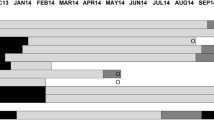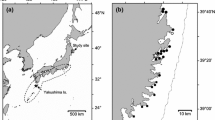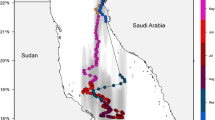Abstract
The movements and behavior of nine female leatherback sea turtles, Dermochelys coriacea (L.) were monitored for up to 370 days from their nesting beaches on the Caribbean island of Trinidad between 1995 and 2004 using satellite-linked time and depth recorders. During the inter-nesting period (typically March–July) turtles ranged widely, but frequented the area around Galera Point on the NE corner of Trinidad. Diving depths were typically <51 m. Upon leaving Trinidad, the three longest tracked turtles moved to higher latitude foraging areas, NE of the Flemish Cap; along the continental shelf of the Iberian peninsula to the Bay of Biscay; and along the N. Atlantic subtropical front, where they remained until the end of November. Dives were initially deep (100–300 m) and long (>26 min) as the turtles left the Caribbean, but became very shallow (>50 m) and short at high latitudes. Between mid-October and mid-November, the turtles left high latitudes for a presumed foraging area in the Mauritania upwelling where they resided until their tracking records ended. Diving remained relatively shallow. It is proposed that movements of these turtles from one foraging area to another are driven by the opportunity to forage in areas of distinct oceanic structure which serve to concentrate their gelatinous prey (e.g., salps, Scyphomedusae, Siphonophora) either at or below the surface.





Similar content being viewed by others
References
Argos (1996) Argos users manual. Service Argos, Landover
Carr A, Ogren L (1959) The ecology and migrations of sea turtles. Dermochelys in Costa Rica. Am Mus Novit 1958:1–29
Chan E, Eckert SA, Liew H, Eckert KL (1991) Locating the inter-nesting habitats of leatherback turtles (Dermochelys coriacea) in Malaysian waters using radio telemetry. In: Uchiyama A, Amlaner CJ (eds) Biotelemetry XI. Proceedings of the 11th international symposium on biotelemetry. Waseda University Press, Tokyo, pp 133–138
Colbourne EB, Foote KD (2000) Variability of the stratification and circulation on the Flemish Cap during the decades of the 1950’s–1990s. J Northw Atl Fish Sci 26:103–122
Duguy R, Duron M (1984) Observations de tortues luth (Dermochelys coriacea) sur les Côtes de France en 1983. Ann Soc Sci Nat Charente Marit 7:227–230
Duron M, Duron P (1980) Des tortues luths dans le pertuis Charentais. Courr Nat 69:37–41
Duron-Dufrenne M (1987) Biologie Marine: Premier suivi par satellite en Atlantique d’une tortue luth, Dermochelys coriacea. Comptes Rendus Academic des Sciences (Paris), Serie 111 15:399
Eckert SA (1998) Perspectives on the use of satellite telemetry and other electronic technologies for the study of marine turtles, with reference to the first year long tracking of leatherback sea turtles. In: Epperly SP, Braun J (eds) Seventeenth annual sea turtle symposium. U.S. Department of Commerce, NOAA Technical Memorandum NMFS-SEFSC-415, Orlando, pp 294
Eckert SA (2002) Swim speed and movement patterns of gravid leatherback sea turtles (Dermochelys coriacea) at St. Croix, U.S. Virgin Islands. J Exp Biol 205:3689–3697
Eckert SA, Eckert KL (1986) Harnessing leatherbacks. Mar Turtle Newsl 37:1–3
Eckert SA, Sarti LM (1997) Distant fisheries implicated in the loss of the world’s largest leatherback nesting population. Mar Turtle Newsl 78:2–7
Eckert SA, Nellis DW, Eckert KL, Kooyman GL (1986) Diving patterns of two leatherback sea turtles (Dermochelys coriacea) during inter-nesting intervals at Sandy Point, St. Croix, U. S. Virgin Islands. Herpetologica 42:381–388
Eckert SA, Eckert KL, Ponganis P, Kooyman GL (1989) Diving and foraging behavior of leatherback sea turtles (Dermochelys coriacea). Can J Zool 67:2834–2840
Eckert SA, Liew H-C, Eckert KL, Chan E-H (1996) Shallow water diving by leatherback turtles in the South China Sea. Chel Cons Biol 2:237–243
Eckert S, Bagley D, Kubis S, Ehrhart L, Johnson C, Stewart K, Defreese D (2006) Inter-nesting, post-nesting movements and foraging habitats of leatherback sea turtles (Dermochelys coriacea) nesting in Florida. Chel Cons Biol (in press)
Ferraroli S, Eckert SA, Chevalier J, Girondot M, Kelle L, Maho YL (2002) Marine behavior of leatherback turtles nesting in French Guiana for conservation strategy. In: Proceedings of the 20th symposium on sea turtle biology and conservation, NOAA Technical Memorandum NMFS-SEFSC-477:369
Ferraroli S, Georges J-Y, Gaspar P, Maho YL (2004) Where leatherback turtles meet fisheries. Conservation efforts should focus on hot spots frequented by these ancient reptiles. Nature 429:521–522
Frouin R, Frúza FGA, Ambar I, Boyd TJ (1990) Observations of a poleward surface current off the coasts of Portugal and Spain during winter. J Geophys Res 95(c1):679–691
Graham WM, Pagès F, Hamner WM (2001) A physical context for gelatinous zooplankton aggregations: a review. Hydrobiologia 451(1–3):199–212
Hays GC, Houghton DJ, Issacs C, King RS, Lloyd C, Lovell P (2004a) First records of oceanic dive profiles of leatherback turtles, Dermochelys coriacea, indicate behavioral plasticity associated with long-distance migration. Anim Behav 67:733–743
Hays GC, Houghton DJ, Myers AE (2004b) Pan-Atlantic leatherback turtle movements. Nature 429:522
Hooge PN, Eichenlaub W, Solomon E (1999) The animal movement program. USGS Alaska Biological Science Center, Anchorage
Hughes G, Luschi P, Mencacci R, Papi F (1998) The 7000 km oceanic journey of a leatherback turtle tracked by satellite. J Exp Biol Ecol 229:209–217
IUCN (2004) 2004 IUCN red list of threatened species. http://www.redlist.org
James M, Eckert SA, Fricker B, Fricker B (2005a) Local and long-distance movements of leatherback turtles (Dermochelys coriacea) satellite tagged off Eastern Canada. In: Coyne MS, Clarke RD (eds) Compilers. Proceedings of the 21st annual symposium on sea turtle biology and conservation. NOAA Technical Memorandum NMFS-SEFSC-528, pp 368
James MC, Eckert SA, Myers RA (2005b) Migratory and reproductive movements of male leatherback turtles (Dermochelys coriacea). Mar Biol 147:845–853
James M., Ottensmeyer CA, Myers RA (2005c) Identification of high-use habitat and threats to leatherback sea turtles in northern waters: new directions for conservation. Ecol Lett 8:195–201
Leary TR (1957) A schooling of leatherback turtles, Dermochelys coriacea coriacea, on the Texas coast. Copeia 1957(3):232
Luschi P, Sale A, Mencacci R, Hughes GR, Lutjeharms JRE, Papi F (2003) Current transport of leatherback sea turtles (Dermochelys coriacea) in the ocean. Proc R Soc Lond B 270(Suppl):S129–S132
Lutcavage ME (1996) Planning your next meal: leatherback travel routes and ocean fronts. In: Keinath JA, Barnard DE, Musick JA, Bell BA (eds) Proceedings of the 15th annual workshop on sea turtle biology and conservation. NOAA Technical Memorandum NMFS-SEFSC-387, p 355
Mittelstaedt E (1991) The ocean boundary along the northwest African coast: circulation and oceanographic properties at the sea surface. Prog Oceanogr 26:307–355
Morreale SJ, Standora EA, Spotila JR, Paladino FV (1996) Migration corridor for sea turtles. Nature 384:319–320
Pingree RD, Garica-Soto C, Sinha B (1999) Position and structure of the Subtropical/Azores Front region from combined Lagrangian and remote sensing (IR/altimeter/SeaWiFS) measurements. J Mar Biol Assoc UK 79:769–792
Pritchard PCH (1976) Post-nesting movements of marine turtles—Cheloniidea and Dermochelyidae tagged in the Guianas. Copeia 1976:749–754
Pritchard PCH (1980) Leatherback turtle (Dermochelys coriacea) Catalog American amphibians and reptiles. Soc Study Amph Rept 238:1–4
Pritchard PDH, Trebbau P (1984) The turtles of Venezuela. Soc Study Amph Reptiles Contrib Herpetol 2:1–403
Shoop CR, Kenney RD (1992) Seasonal distribution and abundances of loggerhead and leatherback sea turtles in waters of the northeastern United States. Herpetol Monogr 6:1–67
Southwood AL, Andrews RD, Lutcavage ME, Paladino FV, West NH, George R, Jones DR (1999) Heart rates and dive behavior of leatherback sea turtles in the eastern Pacific ocean. J Exp Biol 202:1115–1125
Standora EA, Spotila JR, Keinath JA, Shoop CR (1984) Body temperatures, diving cycles, and movement of a subadult leatherback turtle, Dermochelys coriacea. Herpetologica 40:169–176
Starbird CH, Baldridge A, Harvey JT (1993) Seasonal occurrence of leatherback sea turtles (Dermochelys coriacea) in the Monterey Bay region, with notes on other sea turtles, 1986–1991. Calif Fish Game 79:54–62
Statistica for Windows (1994) Volume II Graphics 1994. StatSoft Inc. Tulsa, 2830 pp
Stinson ML (1984) Biology of sea turtles in San Diego Bay, California and in the northeastern Pacific Ocean. Master’s Thesis, Department of Biology
Acknowledgements
Partial funding for this study was provided by Amoco Trinidad, WIDECAST, Hubbs-Sea World Research Institute, and Duke University’s McCurdy Fund. The author would also like to thank the Wildlife Section of the Trinidad and Tobago Forestry Division for their support of this project and in particular Nadra Nathai Gyan, Ken Fournillier, and Steven Poon of the Wildlife Section. Finally, I am very grateful to the Nature Seekers and Solomon Aguillera, Dennis Sammy, and Suzan Lakhan of that organization for their steady assistance on the beach and for their conservation and environmental education work. Without such efforts, there would be no turtles nesting at Matura Beach. Substantial improvements to this manuscript were enabled by suggestions of two anonymous reviewers and the editor. This project was authorized by permits from the Wildlife Section, Government of Trinidad and Tobago and Animal Use and Care Committee protocols of Hubbs SeaWorld Research Institute and Duke University.
Author information
Authors and Affiliations
Corresponding author
Additional information
Communicated by J.P. Grassle, New Brunswick
Electronic supplementary material
Rights and permissions
About this article
Cite this article
Eckert, S.A. High-use oceanic areas for Atlantic leatherback sea turtles (Dermochelys coriacea) as identified using satellite telemetered location and dive information. Mar Biol 149, 1257–1267 (2006). https://doi.org/10.1007/s00227-006-0262-z
Received:
Accepted:
Published:
Issue Date:
DOI: https://doi.org/10.1007/s00227-006-0262-z




